► The Multivan is a purpose-built MPV
► Replaces van-based Caravelle
► An even better way to seat seven
Despite appearances, the name, and being manufactured by VW Commercial Vehicles, the Volkswagen Multivan is not based on a van at all. One of the best hybrid family cars you can buy, it’s instead based on the same MQB architecture as an infinity of other Volkswagen Group products, while successfully evolving all the clever interior features that have made generations of Caravelle so popular with practical lifestyle types and executive transport firms.
It’s the first VW of this type with plug-in hybrid power, comes with a DSG automatic as standard, and is available with a reasonably high level of tech, including up to 25 driver assistance features and standard-fit LED lighting.
There are two lengths, seven seats as standard, and you can have it in a somewhat exotic range of colours – including some slightly challenging two-tone hues. These and the chrome beltline option are an attempt to marry the Multivan’s aero- and safety-optimised exterior design with the cultish Microbus heritage.
At a glance
Pros: flexible and spacious interior, neat and tidy to drive, one of the best seven-seaters on sale
Cons: usual VW infotainment frustrations, DSG a little lazy and lacklustre
What’s new?
VW finds itself in a slightly odd position just at this moment, as it has no less than three similarly sized and shaped MPVs in this space right now. As well as this model, the firm has just launched a new Volkswagen Transporter, which – in some markets at least – will spawn a people-carrying Caravelle variant even though the Multivan effectively replaced the previous version. Then there’s the all-electric ID.Buzz, which plays the retro card even harder but doesn’t have the same degree of interior intelligence.

Frankly, we see little reason at this stage to turn away from the Multivan. The new Transporter is unlikely to be as slick to drive – it uses the Ford Transit Custom van platform now – and the ID.Buzz is far less practical, in terms of both EV-related challenges and the rather unflexible interior. If you want a large, people and luggage friendly bit of ultra-practical Volkswagen, the Multivan is it.
Underlining this fundamental usefulness, VW has turned to the Multivan for its latest camper – which you can read all about in our dedicated VW California review.
What are the specs?
Even though we’ve just done over 1,000 miles in the plug-in hybrid variant, the Multivan is going through a transitional period – the practical upshot of which is that only the 2.0-litre TDI and 2.0-litre TSI models are available to order at the moment.
Diesel is certainly the least cool fuel but it’s also probably still the best fit for this kind of vehicle, delivering 266lb ft as well as 148bhp in addition to eco-friendly twin-dosing tech and the potential for more than 40mpg. Which you’ll struggle to see in any of the other engines.

At launch a 134bhp 1.5-litre TSI was offered alongside the 201bhp 2.0-litre TSI – both with seven-speed DSG – while at the top of the tree was the 215bhp eHybrid. This pairs a 1.4-litre TSI with an electric motor, integrated into its six-speed DSG, and is set to be replaced by 1.5-litre eHybrid with 241bhp at any moment, hence the hiatus from the pricelist. We believe it’s unlikely the smaller standalone petrol will return.
In our most recent experience, the original eHybrid will do around 38mpg, even if you don’t charge the battery regularly. Something that can be done by the engine as well as a plug, which is useful during longer motorway trips when you want to be able to cruise around on electricity once you arrive. We also have long-test experience with the 201bhp variant, which achieved an average of only 28mpg.
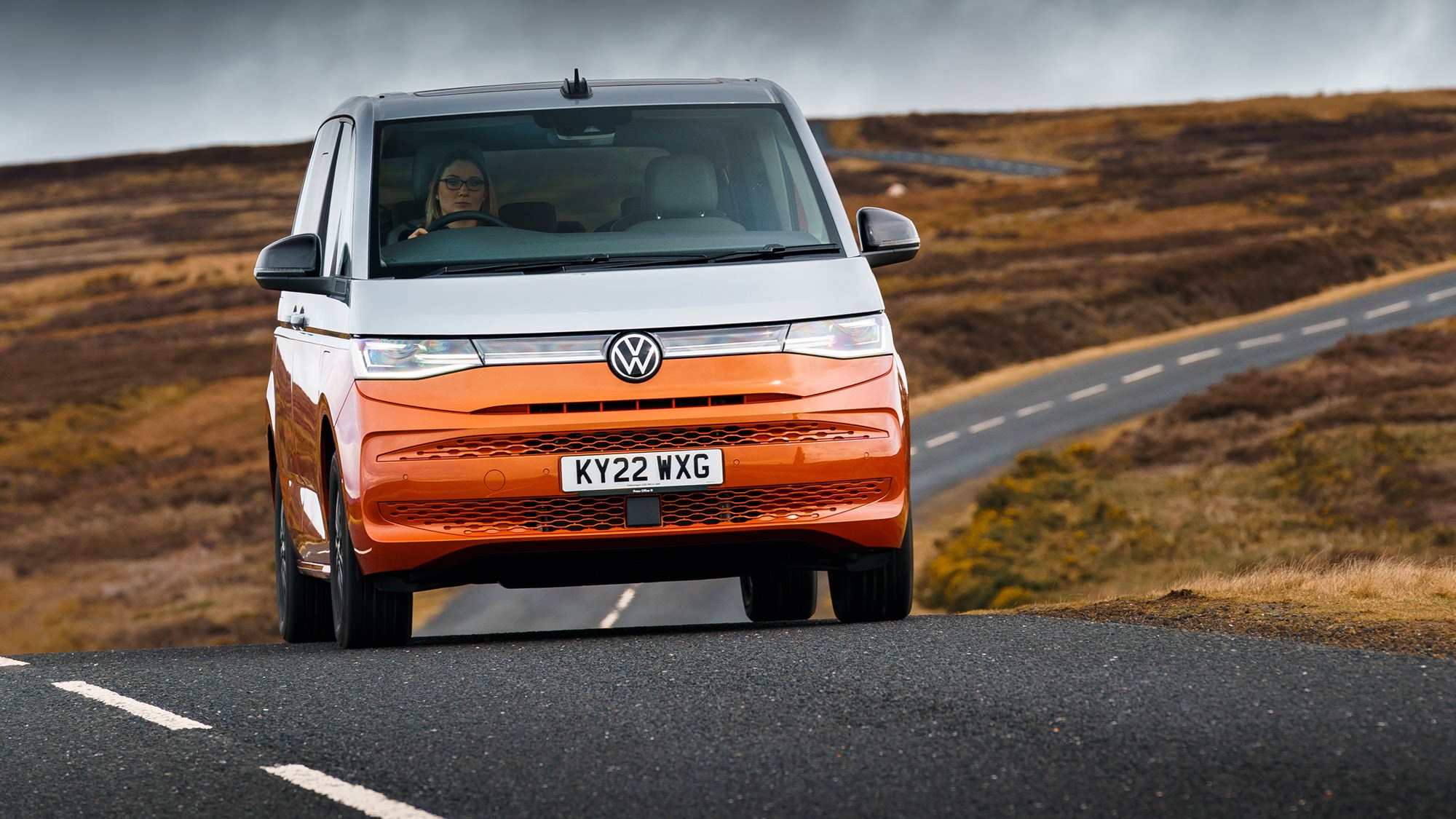
The 1.4-litre eHybrid will do 0-62mph in 11.6sec, which for context is 2.2sec slower than the 2.0-litre petrol, handicapped by a kerbweight penalty of around 100kg. It’s not especially pleasant to listen to when straining, either, but the 31-mile claimed electric range (more like 20-25 miles in the real world) does at least allow for some zero emissions school runs and so forth.
As mentioned, the Multivan comes in standard and long forms. The latter is extended about 200mm, all added after the rear axle. This means a useful amount of additional boot space with all seven seats in position but a greater challenge to park. Even the standard model is near-as-dammit 5m long. But a sub-2m height means overhead restrictors shouldn’t be an issue on either version.
How does it drive?
It is a big beast – wider and longer than the Caravelle as well as lower – so you’re always conscious of that. It’s also a large hollow chamber with seats in, so those comparisons remain. However, the body structure is much stiffer and the suspension has been optimised to within an inch of its life, including larger bushings and aluminium components. Which together with the forged alloy wheels means unsprung mass has been reduced by a chunky 45kg.
You also sit further back, in a driving position that’s less upright and bus-like, facing a digital instrument cluster and an infotainment screen that’s 10.0 inches across in its smallest format. Add the tiny toggle for the standard-fit shift-by-wire DSG setup and the optional head-up display, and it feels pretty modern from behind the wheel.
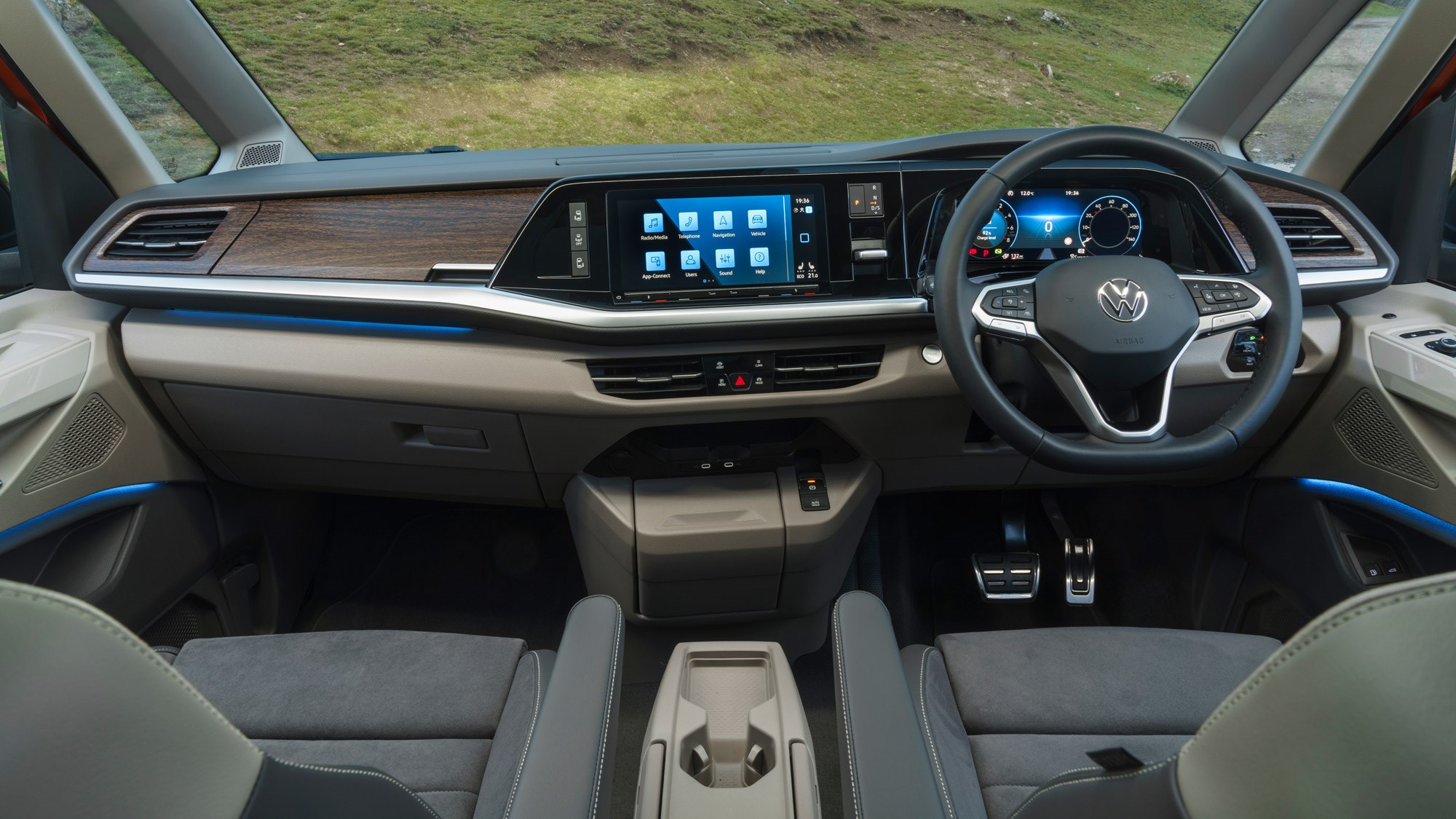
The improvements continue as you set off. There are fewer rattles and shimmies, bumps are absorbed rather than summited, and the steering is much more direct, if not exactly overburdened with feedback. Fortunately, this added sharpness is accompanied far more decisive turn-in and much greater resistance to understeer – you can actually drive the Multivan with some enthusiasm, in situations where the Caravelle might require careful management. Relatively speaking.
Dynamic Chassis Control has been available. But the non-adjustable suspension works just fine – seemingly with reduced resonance as well, which is a mild issue with the DCC on some urban surfaces – so we’d spend the money on something else. Compared with a Caravelle, the Multivan officially leans around 25% less (yes, VW has a stat for that), which feels about right on the road. Basically, it’s still a big bus, but noticeably neater and tidier on the move.
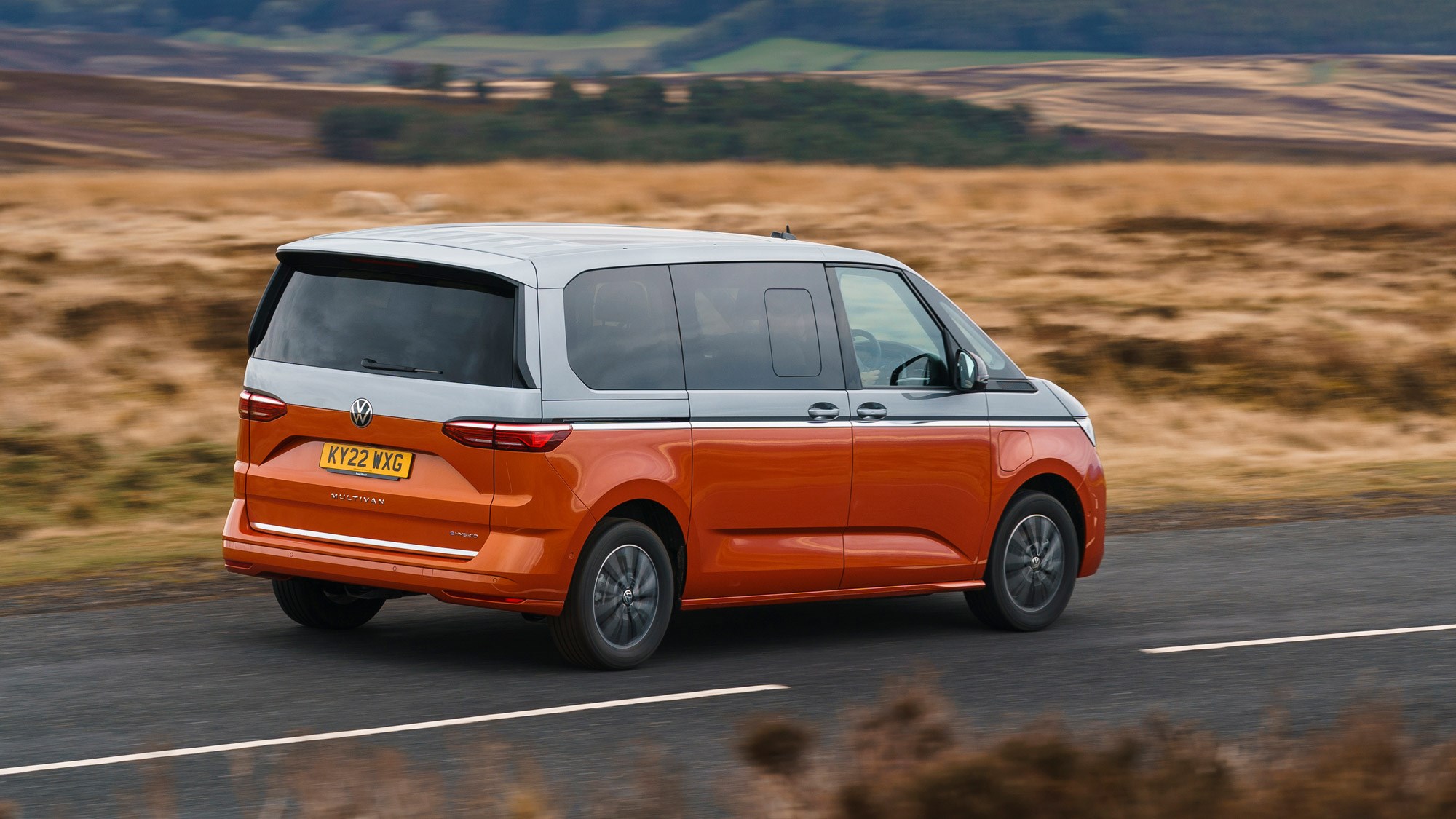
As for the engines, the smaller turbo petrol is perfectly fine around town but becomes gutless in the face of a moderate incline at speed – and that’s with just two people onboard. The bigger turbo petrol is more satisfying in this respect, but sounds reedy and will be a boon to your local fossil-fuel emporium.
That leaves the eHybrid as the best all-round option if you don’t want a diesel. This cruises comfortably, has a decent kick from the e-motor assistance at speed, and does the really rather pleasant EV thing without issue. A fine way for lots of people to cover lots of miles.
What about the interior?
This is evolution, not revolution – and there may even be a couple of backward-seeming steps if you’re a Caravelle owner. But if you’ve got a lot of people and luggage to shift, this is the top contender for your cash unless you’re willing to go to Mercedes V-Class levels, and even then the VW has plenty of appeal.
The most significant change inside compared to previous Volkswagen MPVs is that all seats are now individual chairs. Not only are these 25 per cent lighter than those of the Caravelle – meaning 23-29kg depending on spec, making them easier to remove (particularly compared with the old 90kg rear bench) – a set of three rails running the length of the cabin gives you a huge amount of versatility about their positioning.
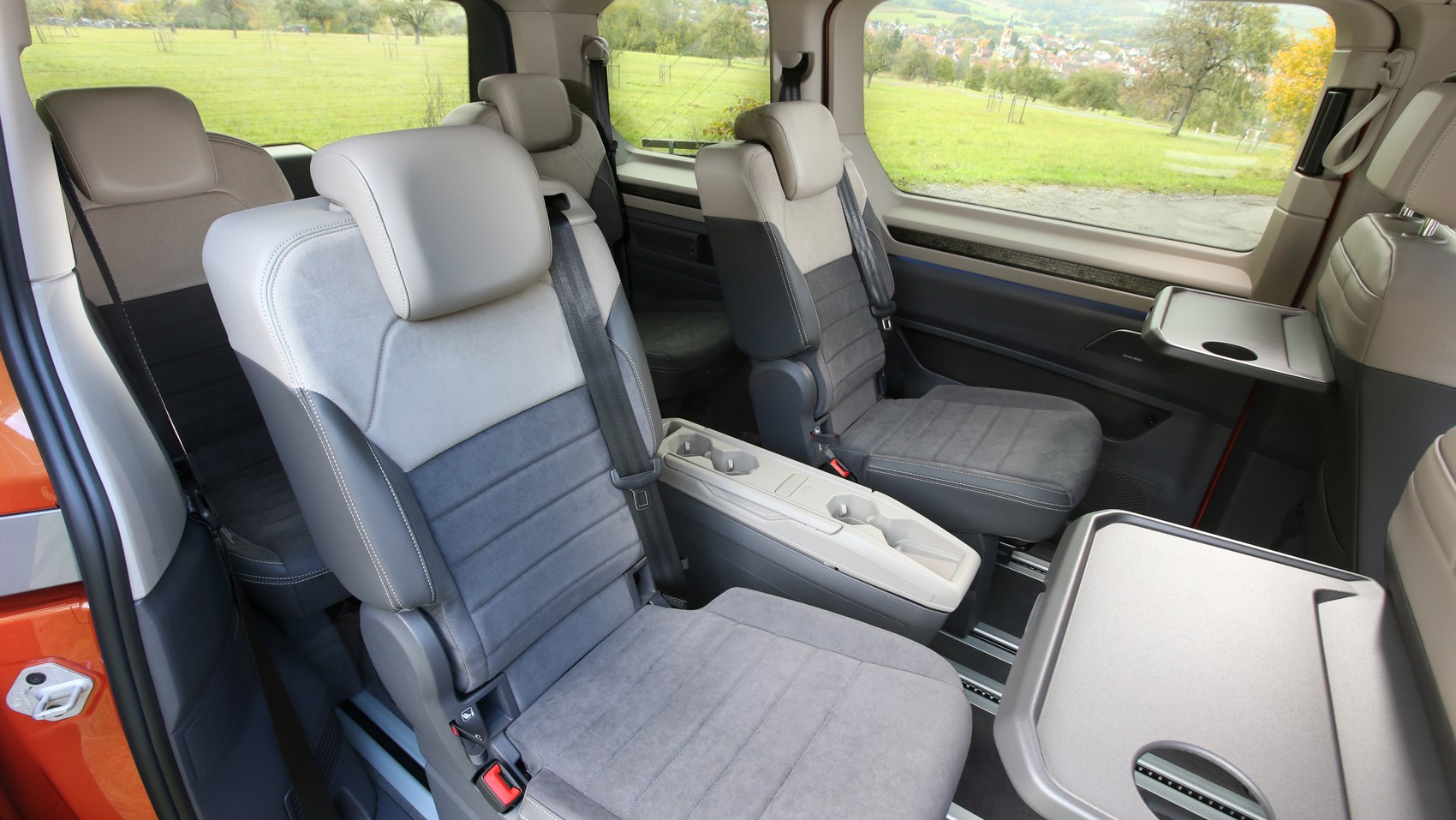
The outer pair of rails even feature an electrical connection, meaning the outer rear seats can be heated – a first for this type of arrangement. What’s more, the updated transforming table in the back can now slide all the way through to the front, where it can function as a centre console or simple stay out of the way of the kids.
On the less good front, the middle row seats no longer swivel on their bases. So if you want to create a mobile lounge you have to physically lift them and turn them round – which is easier than before due to the weight reduction but still a bit of a workout.
It’s also still something of a scramble to get into the back row. Volkswagen says there’s been no reduction in headroom versus the old Caravelle, even though the Multivan’s roofline is 43mm lower. But it feels less spacious inside, perhaps because of the skinnier windows. A massive 1.8m2 panoramic roof can compensate for this.
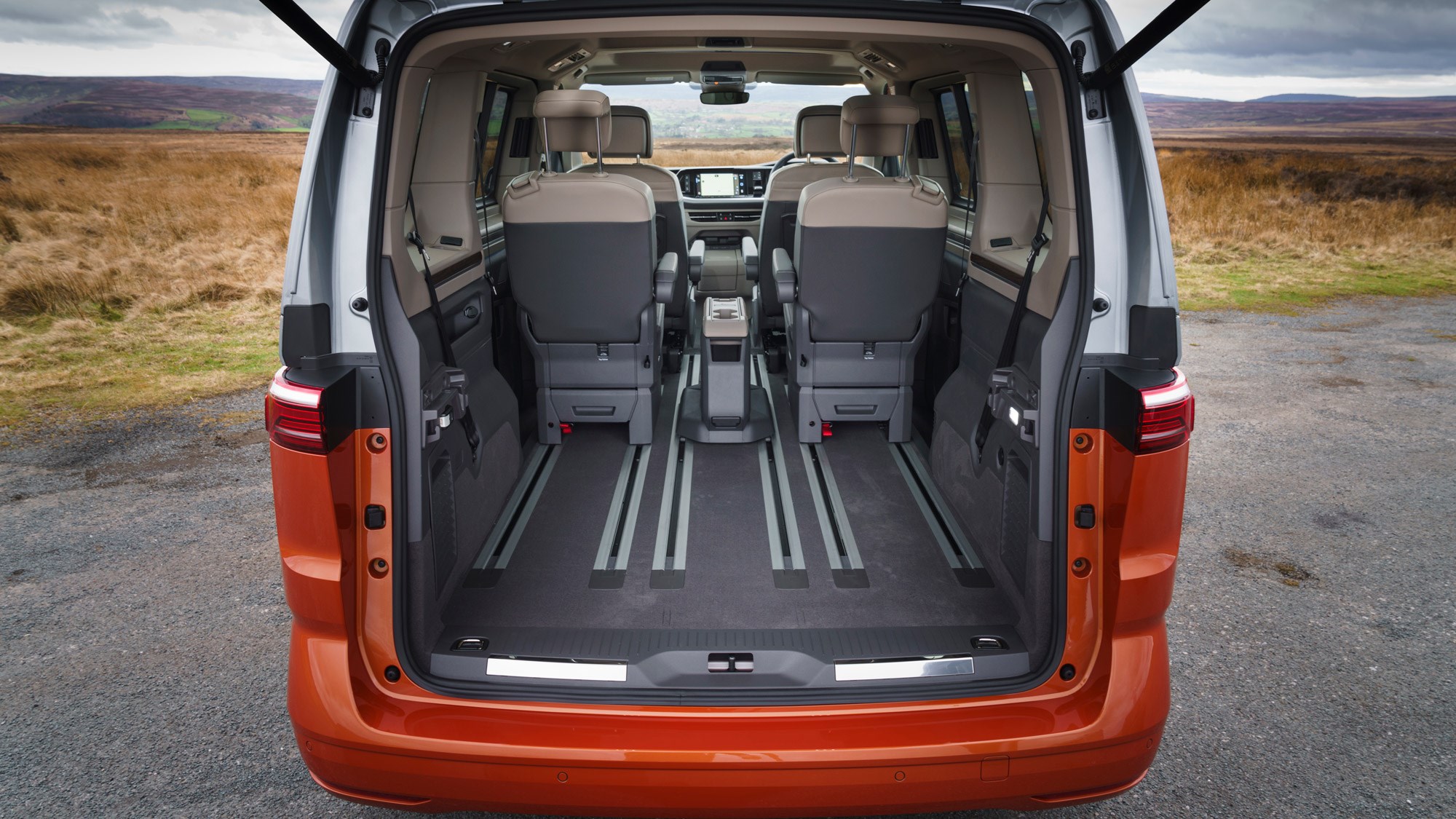
The digi-dials are clear enough, though the infotainment comes complete with all the usual touch-sensitive frustrations of recent VW Group products. Having just four standard USB C ports seems a little limiting if you’re planning to pack the thing with kids who otherwise require surgically removing from their mobile devices.
The optional power-sliding doors and power-opening tailgate can now be activated by a foot-waggle, which is helpful when your hands are full until you accidentally activate the door closing process while belting a tumultuous toddler into their child seat; this probably won’t crush you but it’s still a pain and suggests the system hasn’t quite been fully thought through.
Before you buy (trims and rivals)
The Multivan comes in Life and Style specifications. All get factory satnav, digital instrument cluster, app-connect for smartphones, keyless start, park assist with front and rear sensors and rearview camera, adaptive cruise and autonomous emergency braking.
Style adds 17-inch alloys, IQ Light matrix LED headlights, ambient lighting, three-zone climate control, heated windscreen, heated front seats and upgraded upholstery. Plus electric doors. Life is currently only available with the diesel, while the Style offers the choice of TSI and TDI.
Rivals-wise, the V-Class is the premium alternative – everything else is truly van-based now, and not as good as the VW.
Volkswagen Multivan: verdict
If you like big bus and you cannot lie, this is the place to start if you’re shopping for a new model. The interior flexibility surpasses everything else in the sector – though the Mercedes V-Class remains a strong challenger if you’re looking for maximum lux – and it drives better than all those paltry van-based alternatives as well.